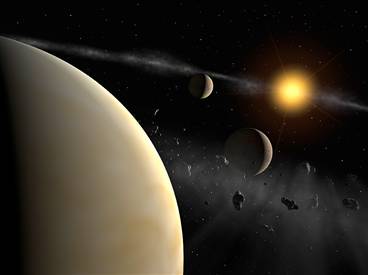
(MSNBC) "For the first time, we have discovered a planetary system composed of several Neptune-mass planets," said study team member Christophe Lovis of the Geneva Observatory in Switzerland.
The setup is similar to our own solar system in many ways: The outermost planet is located just within the star's habitable zone, where temperatures are moderate enough for liquid water to form, and the system also contains an asteroid belt.
The newly discovered planets have masses about 10, 12 and 18 times that of Earth, and they zip around the star in rapid orbits of about nine, 32 and 197 days, respectively.
Although the two inner most worlds are probably too close to the sun, the outer one lies within "the habitable zone" making it a prime target for colonization. Despite being a Neptune sized planet, it may have lunar bodies which would make them prime candidates for future colonies.

(MSNBC) Recent observations by NASA's Spitzer Space Telescope last year revealed that HD 69830 also hosts an asteroid belt, making it the only other sunlike star known to have one.
When the asteroid belt was found, it was suspected that there might be an unseen planet that was shepherding the asteroids; it now seems that there is more than one shepherd. The researchers think the asteroid belt could lie between the two outermost planets, or beyond the third planet.
This star system is about 41 light years away from our own and lies in the Puppis the Stern constellation. Although we do not have the technology to view asteroids, it would be interesting to figure out their composition (as it would increase the value of this system for future colonists).
Want more space geek news? Then subscribe below via email, RSS or twitter for free updates! Prefer another service? How about via RSS or follow Colony Worlds on Twitter!




![ColonyWorlds[at]Gmail[dot]com](http://img.photobucket.com/albums/v438/hiddennook/ColonyWorlds.png)







No comments:
Post a Comment
You can either visit the stars or watch them from afar.
But if you choose the former, you'll definitely get a better view.
~Darnell Clayton, 2007
Note: You do not need a Blogger account in order to comment, but you do need to solve the universal puzzle below.